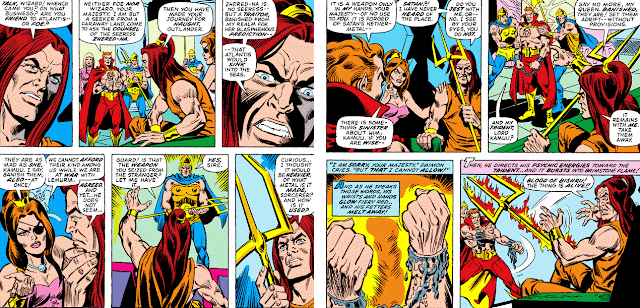Having told the story of the demise of the surface continent of Atlantis as part of a brief feature appearing in the Sub-Mariner book during 1973, writer Steve Gerber and artist Jim Mooney never revisited the series until nearly a year later when both were bringing their talents to Marvel Spotlight and its then-resident character, Daimon Hellstrom, the Son of Satan. Yet rather than continuing where they left off, they instead decided to include the city of Atlantis as part of an investigation which Hellstrom was conducting (along with para-psychologist Dr. Katherine Reynolds and divinity student Byron Hyatt) into a gathering of cultists that watched in surprise as the flame from Hellstrom's trident inadvertently triggered the creation of a mammoth, flaming serpent, which Hellstrom recognized as the dreaded Kometes of ancient legend.
But as Hellstrom and his friends research Kometes, they come across shocking information which leads them to believe that its appearance signals that the world has twenty-four hours left before it will be fundamentally altered. And preventing that fate will involve an extraordinary journey to a cataclysm which occurred twenty-thousand years ago.
True to his word, Hellstrom and his companions appear on a fishing boat within sight of their incredible destination--a domed city which, if the seeress they've come to see is correct, will soon be at the bottom of the ocean.
As we can see, the colorist error which previously resulted in the Atlanteans of this era resembling in skin tone the blue-skinned Atlanteans of Namor's kingdom has been corrected this time around--and Emperor Kamuu, his queen, Zartra, and the rest of the city's population (and, for that matter, the rest of their empire) now resemble surface-men and women, as was the intent in the prior year's Tales Of Atlantis. It makes quite a difference, in that the reader need not be saddled with the distraction of trying to make sense of the discrepancy as the story progresses; and as a result, we're free to give our full attention to Hellstrom's efforts to conduct his business with Kamuu regarding the whereabouts of the seeress named Zhered-Na.
Unfortunately, Hellstrom will meet with disappointment in that regard, while finding himself and his party forced to leave Atlantis less peacefully than when they arrived.
Given what we know of Zartra and Kamuu from their prior appearance, it's frankly surprising to see both of them be content to just sit on their thrones while Hellstrom makes his move, instead of leaping into the fray with swords drawn, circle of fire or not--particularly Kamuu, who normally would be lunging at Hellstrom for the indignity of seeing his will overturned by Hellstrom's trident being forcibly torn from his grasp. Nevertheless, we've seen the last of the rulers of Atlantis in this story, as Hellstrom and his two virtually helpless associates make a heated dash for the docks.
Fortunately for Byron, Dr. Hamilton intervenes, and Hellstrom's rational mind regains control--after which Hellstrom and Byron call a truce between themselves, at least for the time being.
Yet there still remains the task of contacting Zhered-Na--and when Hellstrom succeeds, he is drawn to the astral plane with her where she makes clear the true threat to be dealt with is not Kometes, but mankind itself, which only a cataclysm can purge. The revelation leads to a meeting with a being who calls himself Spyros--but we discover he is better known by another name, one which extends back to the dawn of creation.
Hellstrom makes a fair point, in that little is accomplished from a forced reckoning by way of a destructive cataclysm; though if we're making a comparison here between ancient times and the 1970s, arranging for a near-biblical cataclysm to descend on either period seems a drastic step to take--as arguably drastic as the Genesis flood, another cataclysm from ancient times, the purpose of which was to essentially wipe the slate clean and start over by destroying all life on Earth except for a select few.
With the crisis passed (at least for Hellstrom's time period), Hellstrom is returned to his body where he must hastily arrange for his party's escape from the cataclysm which remains.
It's a pity that Gerber found it necessary to so hastily divert Hellstrom from further interaction with Kamuu and Zartra, while only giving him token conflict with the Atlantean forces in his path. Any one man who can successfully fight off the forces of Hell is going to be a handful for even Kamuu and his warriors en masse; on the other hand, with the clock ticking on their approaching doom, it was probably the right call to spare them from having to deal with the son of Satan so close to their end.













No comments:
Post a Comment